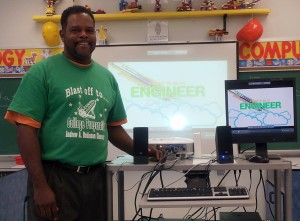(ThyBlackMan.com) STEAM is a growing educational initiative that encourages hands-on learning that is student centered in learning and teachers as facilitators not lecturers. The involvement of Scientific inquiry using experimentation, integration of diverse Technologies to meet the needs of diverse learning modalities, using design strategies for problem solving in Engineering, recognizing the importance of the Arts in dynamic brain function and even applying Mathematics to encourage higher order and critical thinking skills.
HBCU’s or Historically Black Colleges and Universities have for years encouraged STEAM education. The educational models have been separated by traditional teaching styles and strategies, but with the changes in integration of tech, collaboration and cooperative learning it is important to combine learning strategies.
HBCU’s have a unique opportunity to serve with great potential students who have a passion to be involved in STEAM careers. STEAM and STEM careers are growing because the use of technology allows for new directions of research, discovery, creativity and innovation. The historical significance of HBCU’s is their service to prepare “Students of Color” with marketable skills to compete globally, establish partnerships that are international.
globally, establish partnerships that are international.
The truth is still important that HBCU’s service “Students of Color” that white colleges and universities do not consider investment worthy. As in the traditions of the past; Timbuktu home to a 25,000 student university. Where learning was involved long before Europeans were even reading or writing.
As a graduate of South Carolina State University, HBCU institutions still understand the need for tutorial, mentoring, monitoring and collective services that guide students to educational obtainment to the goal of graduation and employment. Students in today’s higher educational institutions must take dvantage of the resources of HBCU’s that are not offered at other institutions.
Recently Florida A&M University Engineering Department was honored because of its diversity in supporting women in the fields of Engineering. The same field that I’m working to encourage and excite my K thru fifth grade students to embark on.
The opportunities that HBCU’s present are too often over shadowed by larger universities, the quality of educational obtainment is no less and often better because of smaller class sizes and the personal connectivity students receive from instructors. Stated by Decatur B Rogers, executive assistant
to the President for Science, Technology, Engineering and Math (STEM), “If this country wants to remain competitive, then we must continue to train our students to be competitive.”
The last 10 years have seen a growth in the effort to augment the diversity in STEM and STEAM fields. There needs to be an increase in graduate degree enrollments and HBCU’s must prepare underrepresented minority groups in STEM and STEAM fields. One of the important ways is to encourage more STEM and STEAM educated and trained teachers in these areas willing to be teachers. Sharing their knowledge, passion and skills to educate generations of new STEAM and STEM career minded youth of color.
As an Engineering and Technology teacher at a dedicated STEAM and Title One school my mission is to set a foundation of learning that is based on integrating elements of diverse instruction to embed in students at the elementary level the potential of educational success and optional career choices. My efforts as a educator, African American teacher and male teacher (which is becoming a rarity) prove that diversity is needed in the classrooms of schools to inspire and offer role models to Black students.
HBCU’s must be adaptive and flexible in its curriculums to provide the best educational models that lead to viable careers. Even the absence of careers allow for new career opportunities to be developed by entrepreneurials with vision and 21st century skill-sets. These skills increase economic stability, research opportunities and international networking alliances.
Through the years the threat of extinction has been faced by HBCU’s; with the efforts of curriculum changes, engaged and knowledgeable faculty, national and international collaboration and working with public, charter and private schools HBCU’s will provide the men and women that will be the future leaders in STEM and STEAM.
Public education must provide opportunities for creativity in instruction as they implement curriculums that set the foundation for students from elementary school to high school. These students will be enrolled in HBCU’s as thousands continue to do so. I’m a proud parent of a soon to be FAMU graduate, my son is majoring in Biology (microbiology) with a bright future in STEM and STEAM.
There needs to be a continued effort to meet the needs of African American males to be educators, engineers, scientists, explorers and innovators. To ignite the fires of learning in “Students of Color.” HBCU’s must take hold the responsibility to educate future generation of “Women of Color” and guide them to contribute to society.
Conclusion:
HBCU’s are a reminder that for “Students of Color” their institutions are unique and vital. Just as Timbuktu was a scholarly centre in Africa during the 12th century. It was a place of learning, educational obtainment, scholarly discussion and attracted many religious scholars opening the understanding f religious tolerance.
HBCU’s are still vital in the 21st century and create a culture similar to Timbuktu where prosperity of the city attracted Africans and Arabs then Europeans who were both scholars and merchants.
HBCU’s attract diverse cultures because of its welcoming atmosphere and non-judgmental pattern of acceptance of other cultures. This is not always found at traditionally white institutions.
It should be known that “People of Color” are decedents of scholars, business men and women, traders, royalty and adventurers. The Golden Age of Africa when books were written before Europe was even reading, in Timbuktu, books were imported and copied. Educational resources of advancement was ongoing in the city. The universities and libraries contained unparalleled scholarly works.
HBCU’s are decedents of Timbuktu and other scholarly cities in mission and principle so Historically Black Colleges and Universities have a reason and purpose to survive and be of service to communities that still desire learning and growth in the 21st century and beyond.
Resources:
STEM in HBCU’s
http://www.thurgoodmarshallfund.net/stemresearch/stem-hbcu-programs
Gifted Blacks In STEM
http://giftedblackstem.org/hbcu.html
Staff Writer; William D. Jackson
Find out more about this talented writer over at; OCS For Education.
Also check out; http://www.About.Me/WilliamDJackson




















I talk about this in my book, how our best and brightest choose to go to the same schools that at one time didn’t even want them to come there. How our athletes choose to go to more notable colleges, rather than bringing all those millions they make to our colleges.
I can’t put all the blame on the students because they weren’t taught about the great history of Black colleges and what they represented for our people. It’s as if our children have no clue about their history. This is our fault, not theirs. We as a people have to do a better job of teaching Black history to our children and get them to realize the importance of supporting HBCU’S.
To give you an example of the lack of support we have for our colleges. I just read a stunning report that said, less than 50% of those who graduate from Black colleges give back to their schools. I think it’s less then that, but I don’t have the stats in front of me. No wonder their recruit white students. We can’t continue to blame our children for the problems we continue to pass on.
Black Unity means financial independence and happiness
The historically black colleges and universities (HBCU)and the work being done by people like this author, is a vital necessity in properly educating black people. In order for us black people to thrive, we must employ ourselves, educate our children and compete in society as a independent people. With the present education system, our children are being taught that Ignorance is acceptable and choosing a path that gives the greatest rewards, with the least amount of effort is the way of life. As long as we leave the education our children to others they will view our ancestors as savages. The answer lays in education, taught from the prospective of securing the survival of our people.